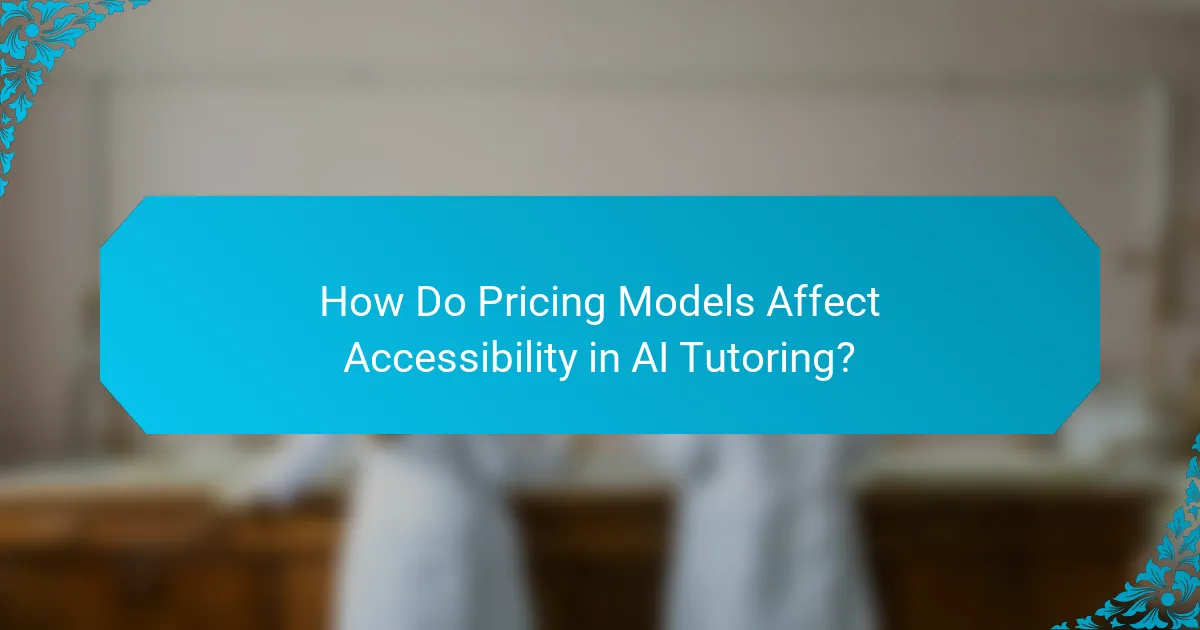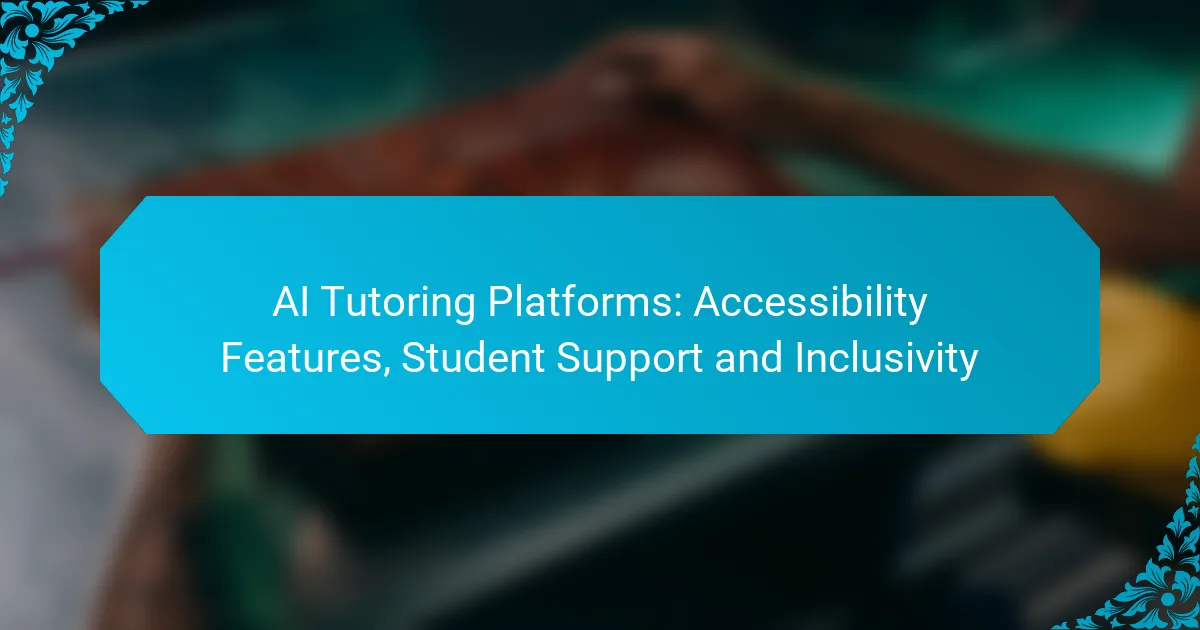AI tutoring platforms are increasingly prioritizing accessibility and inclusivity, ensuring that all students can engage with educational content effectively. By incorporating features such as screen reader compatibility, customizable interfaces, and multilingual support, these platforms cater to diverse learning needs and create personalized learning experiences. This commitment to inclusivity not only enhances student support but also fosters an environment where every learner can thrive, regardless of their background or abilities.

What Are the Best AI Tutoring Platforms for Accessibility?
The best AI tutoring platforms for accessibility incorporate features that support diverse learning needs, ensuring all students can engage effectively. Key aspects include screen reader compatibility, text-to-speech options, customizable interfaces, and multilingual support.
Platforms with screen reader support
Platforms that offer screen reader support allow visually impaired students to navigate content using audio feedback. This feature is crucial for ensuring that all educational materials are accessible, enabling users to listen to text and interact with the platform seamlessly.
When evaluating platforms, check for compatibility with popular screen readers like JAWS or NVDA. Look for features such as keyboard shortcuts and clear labeling of buttons to enhance the user experience.
Platforms offering text-to-speech features
Text-to-speech features convert written content into spoken words, aiding students who struggle with reading. This functionality can help learners comprehend material better and improve their retention of information.
Choose platforms that allow customization of voice speed and tone, as these adjustments can significantly enhance the learning experience. Some platforms may also offer different languages and accents, providing a more personalized approach.
Platforms with customizable interfaces
Customizable interfaces enable students to tailor their learning environment to suit their preferences and needs. Features may include adjustable font sizes, color contrasts, and layout changes, which can help reduce distractions and improve focus.
When selecting a platform, consider one that allows users to save their settings for consistent use. This can be particularly beneficial for students with specific learning disabilities or attention challenges.
Platforms with multilingual support
Multilingual support is essential for students who speak different languages, ensuring they can access learning materials in their preferred language. This feature promotes inclusivity and helps non-native speakers understand complex concepts more easily.
Look for platforms that offer a wide range of languages and consider how well they translate educational content. Some platforms may provide real-time translation features, which can be advantageous for collaborative learning environments.

How Do AI Tutoring Platforms Support Diverse Learning Needs?
AI tutoring platforms cater to diverse learning needs by offering tailored educational experiences that adapt to individual student requirements. These platforms utilize advanced technologies to create personalized learning environments, ensuring that all learners, regardless of their backgrounds or abilities, receive the support they need to succeed.
Personalized learning paths
Personalized learning paths are designed to align with each student’s unique strengths, weaknesses, and interests. By assessing a learner’s performance and preferences, AI tutoring platforms can create customized curricula that focus on specific skills or topics, allowing students to progress at their own pace.
For example, a student struggling with algebra might receive additional resources and practice problems tailored to their needs, while another student excelling in the subject can move on to more advanced concepts. This approach fosters engagement and motivation, as learners see their progress and achievements reflected in their personalized plans.
Adaptive learning technologies
Adaptive learning technologies adjust the difficulty and type of content presented to students based on their ongoing performance. These systems analyze data in real-time, identifying areas where a student may need more support or challenge, and modify the learning experience accordingly.
For instance, if a student consistently answers questions correctly, the platform may introduce more complex problems to maintain engagement. Conversely, if a learner struggles, the system can provide additional explanations or simpler tasks to reinforce understanding. This dynamic adjustment helps ensure that all students remain challenged yet supported.
Real-time feedback mechanisms
Real-time feedback mechanisms are crucial for helping students understand their progress and areas for improvement. AI tutoring platforms provide immediate responses to student inputs, allowing learners to quickly identify mistakes and correct them before moving on.
This instant feedback can take various forms, such as hints, explanations, or even gamified rewards for correct answers. By receiving timely information about their performance, students can adjust their study strategies and enhance their learning outcomes effectively.

What Inclusivity Features Should You Look for in AI Tutoring Platforms?
When evaluating AI tutoring platforms, key inclusivity features include support for diverse learning needs, tools for collaborative learning, and adherence to accessibility standards. These elements ensure that all students, regardless of their backgrounds or abilities, can benefit from the educational resources provided.
Support for neurodiverse learners
AI tutoring platforms should offer features tailored to neurodiverse learners, such as customizable learning paths and adaptive content delivery. This allows students with conditions like ADHD or autism to engage with material at their own pace and in a manner that suits their cognitive styles.
Consider platforms that provide options for sensory-friendly interfaces, such as reduced visual clutter or adjustable text sizes. These features can significantly enhance focus and comprehension for neurodiverse students.
Collaboration tools for group learning
Effective AI tutoring platforms should include collaboration tools that facilitate group learning experiences. Features like shared workspaces, discussion forums, and real-time feedback mechanisms enable students to work together, fostering a sense of community and enhancing learning outcomes.
Look for platforms that support video conferencing and document sharing, as these tools can help students collaborate on projects and engage in peer-to-peer learning, which is essential for developing social skills and teamwork.
Accessibility compliance standards
Ensure that the AI tutoring platform complies with recognized accessibility standards, such as the Web Content Accessibility Guidelines (WCAG). Compliance indicates that the platform is designed to be usable by individuals with disabilities, including those with visual, auditory, or motor impairments.
Platforms that meet these standards often include features like screen reader compatibility, keyboard navigation, and alternative text for images. Regular audits and updates to maintain compliance are also crucial for ongoing accessibility.

How Do Pricing Models Affect Accessibility in AI Tutoring?
Pricing models significantly impact accessibility in AI tutoring by determining who can afford these services and how easily they can access them. Subscription-based models, free trials, and discounts for underserved communities play crucial roles in making AI tutoring more inclusive.
Subscription-based pricing advantages
Subscription-based pricing often provides a steady and predictable cost for users, making budgeting easier for families and students. These models typically offer a range of features, such as personalized learning paths and 24/7 access to resources, which can enhance the learning experience.
Additionally, many subscription services allow for tiered pricing, enabling users to select plans that fit their financial situation. This flexibility can help ensure that a broader audience can benefit from AI tutoring platforms.
Free trial options for accessibility
Free trial options are essential for improving accessibility as they allow potential users to experience the platform without financial commitment. This can be particularly beneficial for students from low-income backgrounds who may be hesitant to invest in a service they haven’t tried.
Typically, free trials last from one to four weeks and provide full access to features, enabling users to assess the platform’s effectiveness. It’s advisable for users to take advantage of these trials to evaluate whether the tutoring aligns with their educational needs.
Discounts for underserved communities
Many AI tutoring platforms offer discounts specifically designed for underserved communities, which can significantly enhance accessibility. These discounts may range from 20% to 50% off regular subscription prices, making services more affordable for low-income families.
Platforms may also partner with schools or community organizations to provide additional support and resources, further bridging the gap for students in need. It’s beneficial for users to inquire about available discounts and eligibility requirements to maximize their access to educational resources.

What Are the Key Criteria for Choosing an AI Tutoring Platform?
When selecting an AI tutoring platform, consider user reviews, feature sets, and customer support options. These criteria help ensure the platform meets educational needs effectively and provides a supportive learning environment.
Evaluation of user reviews
User reviews offer valuable insights into the effectiveness and reliability of an AI tutoring platform. Look for feedback on the platform’s ease of use, engagement level, and the quality of tutoring provided. High ratings and positive comments often indicate a strong user experience.
Check multiple review sources, such as educational forums and app stores, to get a comprehensive view. Pay attention to recurring themes in the reviews, as they can highlight both strengths and weaknesses of the platform.
Assessment of feature sets
Feature sets are crucial in determining how well an AI tutoring platform can cater to diverse learning styles. Key features to consider include personalized learning paths, interactive exercises, and progress tracking tools. A platform that adapts to individual student needs can significantly enhance learning outcomes.
Additionally, assess the availability of resources such as video tutorials, quizzes, and forums for peer interaction. Platforms that offer a wide range of features tend to provide a more enriching educational experience.
Comparison of customer support options
Effective customer support is essential for resolving issues and ensuring a smooth user experience. Compare the support options available, such as live chat, email assistance, and phone support. Platforms with 24/7 support are often more reliable, especially for students who may need help outside regular hours.
Also, consider the responsiveness and helpfulness of the support team based on user feedback. A platform that prioritizes customer service can make a significant difference in user satisfaction and overall learning success.
